

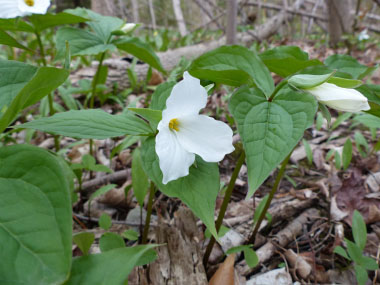
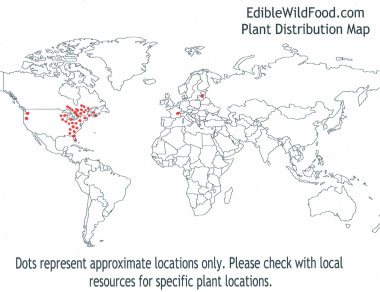
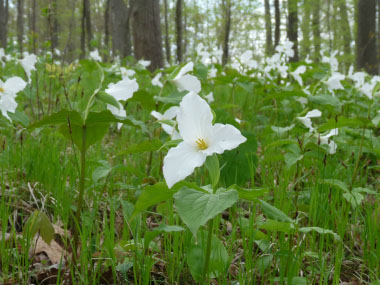


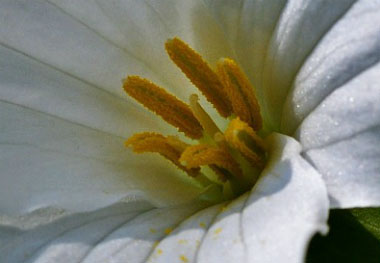
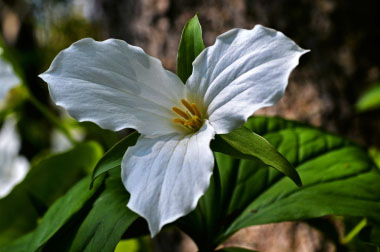
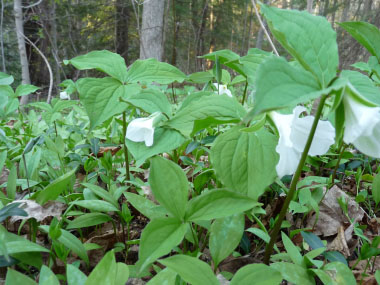
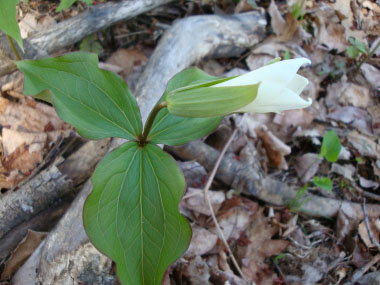
To support our efforts please browse our store (books with health benefits, etc.).
White trillium is the showiest of all trilliums worldwide and is highly prized in Europe and Japan. In springtime many forest floors are totally covered in trilliums. Most botanists believe that the trillium belongs to a separate family of plants called Trilliaceae. Its close relatives are the genus Paris and Trillidium, neither of which is native to North America. Trilliums are slow growers requiring minimum seven years from seed to flowering. Once a seed germinates, the first year’s focus is on the roots only. In its second year, the seedling will produce a single seed leaf. In the third year, the first true leaf will appear. Two or more additional years will be required before the plant produces the three-whorled leaves that we are familiar with.
Distinguishing Features
The trillium is a spring ephemeral that is very easy to identify. This is a fair-sized plant that is easily distinguished by its white three-petalled flower that appear above a whorl of three leaves. White trillium is a perennial plant, arising from a single rootstalk. This rootstalk grows from a short rhizome containing long roots.
Flowers
The white trillium flower has three white petals, elliptical shaped with pointed tips. As the plant matures, the petals turn pink. The flower is solitary and appears above the leaves. The flower stalk (peduncle) is 2 to 12 cm long. It has three green sepals. The petals are about 4 to 7.5 cm long. It has six stamens and a single pistil with an ovoid, greenish-white, 6-angled, superior ovary. Flowers bloom in May and early June.
 Fields
of Nutrition has medicinal benefits and vitamin/mineral content of White Trillium.
Fields
of Nutrition has medicinal benefits and vitamin/mineral content of White Trillium.
Leaves
A whorl of three sessile leaves appears at the top of the smooth, erect stem. Leaves are elliptic to broadly ovate, 12–20 cm (5 to 8”) long and 8–15 cm (3 to 6”) wide. They are glabrous, bases are tapering to rounded; apices are sharply pointed and the margins are entire.
Height
This trillium grows anywhere from 20 to 50 cm (8 to 20”).
Habitat
White trillium typically grows in deciduous forests in Eastern North America. It has been seen in a couple of locations in western U.S. White trillium also grows in a few locations in Europe and Japan. It prefers rich soils in shaded locations with some sun. Trilliums also prefer dry to moderate air moisture.
Edible Parts
The leaves can be cooked and consumed. Due to the (approximate) seven year life cycle it is best to harvest only only leaf per plant. Check with your local laws as this plant may be protected. In the province of Ontario, trilliums are not to be picked if on conservation lands or in provincial parks. If the leaves as well as the flower are picked, the plant could die as it no longer has the ability to produce the energy it needs to take it through the winter into another spring.
Other Name
Wood Lily.
Similar Plants
Red Trillium, Nodding Trillium.
Winter Survival Food Handbook

PDF Plant Magazines
Types of Wild Food
Geographic Zones Seasons
Disclaimer
EdibleWildFood.com is informational in nature. While we strive to be 100% accurate, it is solely up to the reader to ensure proper plant identification. Some wild plants are poisonous or can have serious adverse health effects.
We are not health professionals, medical doctors, nor are we nutritionists. It is up to the reader to verify nutritional information and health benefits with qualified professionals for all edible plants listed in this web site. Please click here for more information.
Why Edible Wild Food?
- Food costs are rising
- Free, wild food is readily abundant
- Wild food adds nutrition to your diet
- Wild food can help treat various medical conditions





